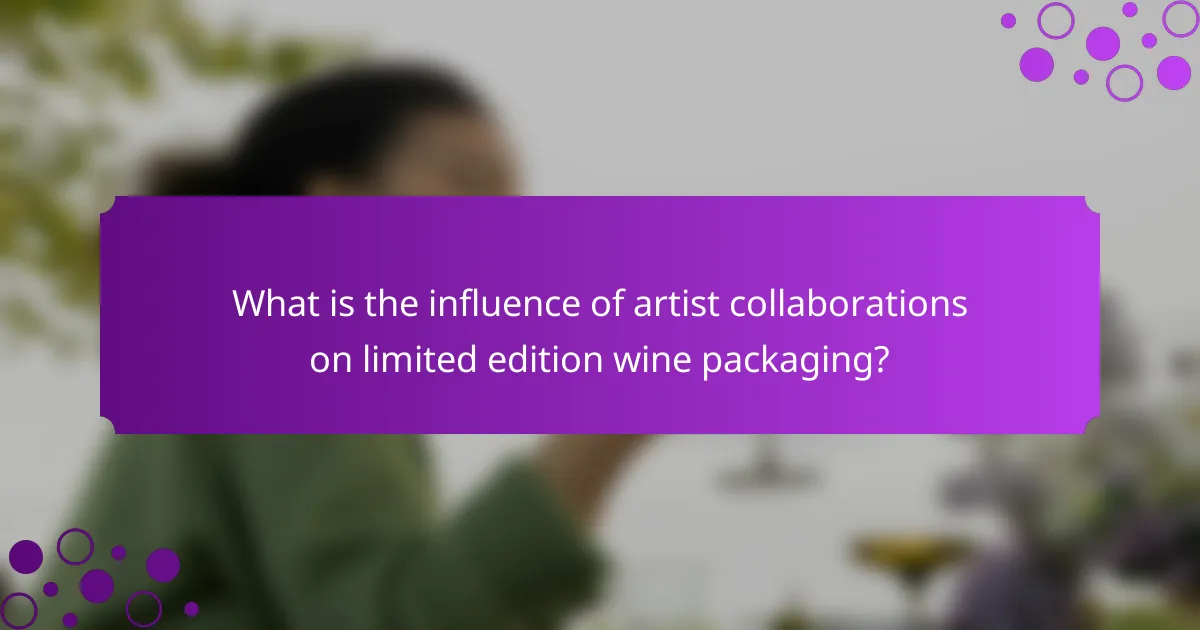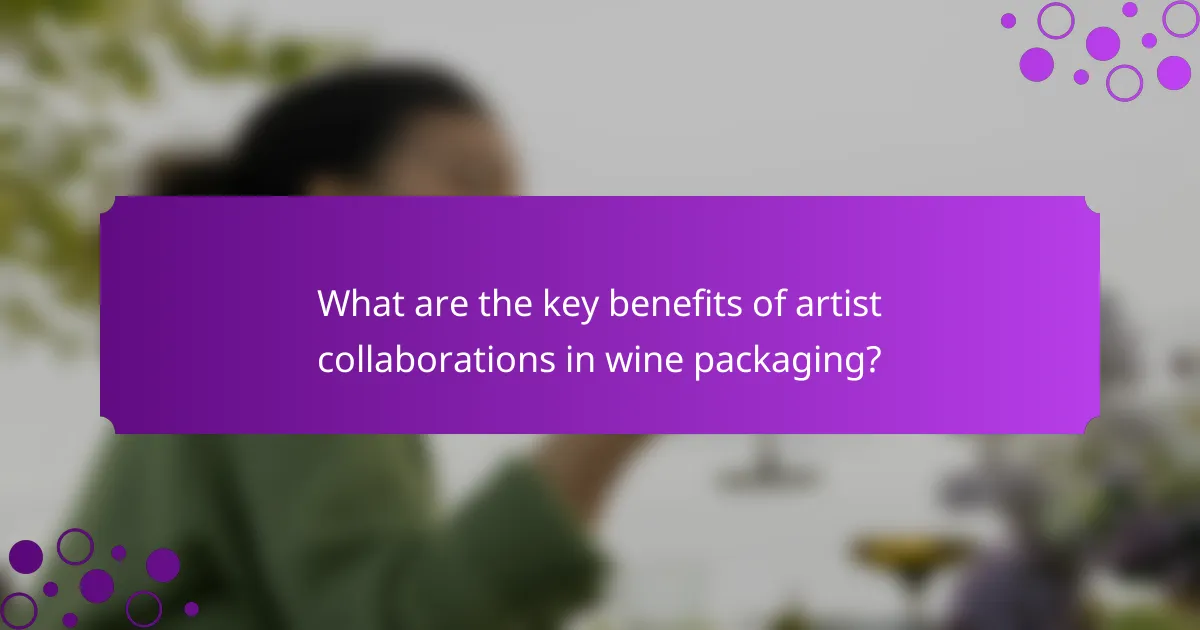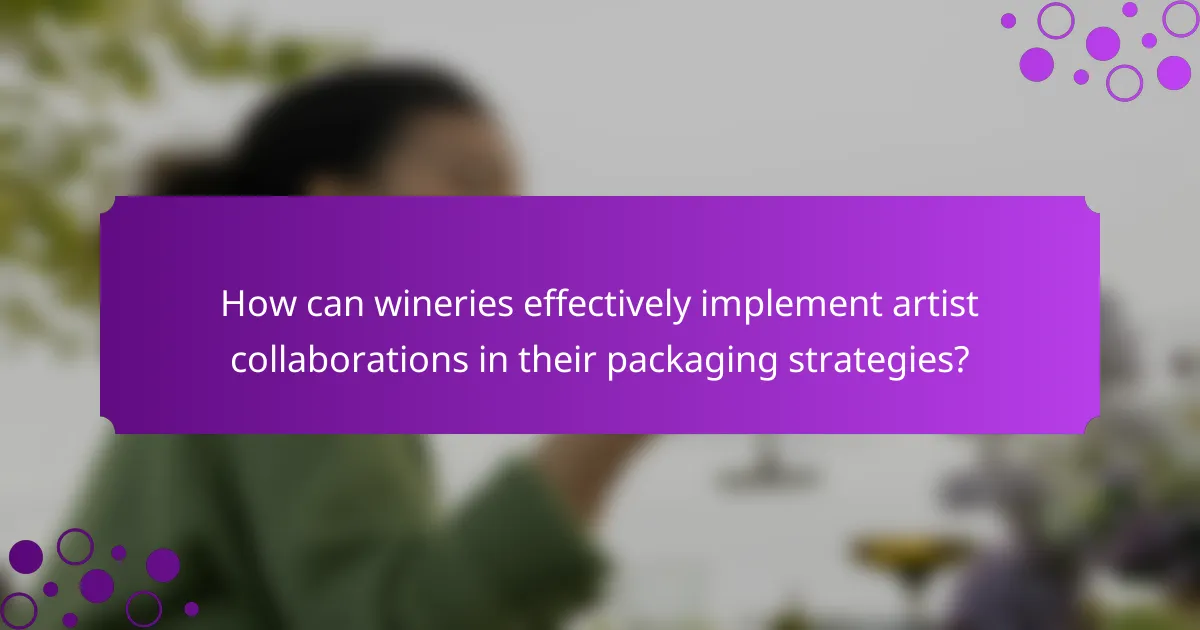
What is the influence of artist collaborations on limited edition wine packaging?
Artist collaborations significantly enhance limited edition wine packaging. They attract attention and create a unique aesthetic appeal. Collaborations with well-known artists can increase perceived value. This often leads to higher sales and consumer interest. For instance, a study by Wine Intelligence found that 70% of consumers are influenced by packaging design. Unique artwork can also tell a story, connecting consumers emotionally to the product. This emotional connection can foster brand loyalty. Ultimately, artist collaborations elevate the overall marketing strategy for wine brands.
How do artist collaborations enhance the appeal of limited edition wine packaging?
Artist collaborations enhance the appeal of limited edition wine packaging by adding unique artistic value. These collaborations create visually striking designs that attract consumers. The artwork often tells a story or conveys a theme, making the product more memorable. Limited edition packaging becomes a collectible item due to the exclusive designs. This exclusivity can increase perceived value among consumers. Notably, research shows that products with artistic packaging can command higher prices. For example, a study by the Journal of Marketing found that limited edition items with artistic elements saw a 20% increase in sales. Overall, artist collaborations elevate the aesthetic and marketability of wine packaging.
What artistic elements are commonly used in wine packaging collaborations?
Artistic elements commonly used in wine packaging collaborations include unique illustrations, typography, and color schemes. Illustrations often reflect the artist’s style and can range from abstract designs to detailed artwork. Typography is selected to convey the brand’s identity and may include custom fonts created by the artist. Color schemes are chosen to evoke specific emotions or themes that align with the wine’s characteristics. Additionally, texture and materials, such as embossed labels or metallic finishes, enhance the tactile experience. These elements work together to create a visually compelling package that attracts consumers. Collaborations often result in limited edition releases, making the packaging a significant aspect of the product’s appeal.
How does the choice of artist affect consumer perception of the wine?
The choice of artist significantly affects consumer perception of wine. An artist’s reputation can enhance the perceived quality of the wine. For example, wines featuring well-known artists often command higher prices. This phenomenon occurs due to the association of the artist’s brand with the wine’s brand. Consumers may perceive artistically packaged wines as more exclusive or premium. A study by the Journal of Consumer Research highlights that unique packaging influences purchasing decisions. Emotional connections to the artist can also drive consumer preference. Overall, the artist’s choice shapes the narrative around the wine, influencing consumer attitudes and behaviors.
Why are limited edition wine packaging designs important in the market?
Limited edition wine packaging designs are important in the market because they create exclusivity and enhance brand appeal. These unique designs attract collectors and wine enthusiasts, driving higher demand. According to a study by the Wine Market Council, 25% of consumers are willing to pay more for limited edition products. This willingness boosts sales and profit margins for wineries. Furthermore, artist collaborations in packaging can increase visibility and attract new customer demographics. Unique packaging often leads to greater social media engagement, which further promotes the brand. Overall, limited edition designs contribute significantly to market differentiation and consumer loyalty.
What role does exclusivity play in consumer purchasing decisions?
Exclusivity significantly influences consumer purchasing decisions. Consumers often perceive exclusive products as more desirable. This perception can lead to increased demand and willingness to pay a premium. Research indicates that limited availability enhances the product’s perceived value. For instance, a study by Cialdini (2009) shows that people are more likely to desire items that are scarce. Additionally, exclusivity can create a sense of urgency, prompting quicker purchasing actions. Consumers associate exclusivity with status and prestige, further driving their decisions. Therefore, exclusivity serves as a powerful motivator in the buying process.
How can unique packaging differentiate a wine brand from competitors?
Unique packaging can differentiate a wine brand from competitors by creating a distinct visual identity. This identity attracts consumer attention on crowded shelves. Unique designs can evoke emotions and tell a story about the wine. For example, limited edition packaging often features artwork from renowned artists. This collaboration can enhance perceived value and exclusivity. Research shows that 67% of consumers consider packaging when making purchase decisions. Unique packaging can also reflect the brand’s heritage or region, further distinguishing it. Brands that invest in innovative packaging can foster brand loyalty and recognition.

What are the key benefits of artist collaborations in wine packaging?
Artist collaborations in wine packaging enhance brand visibility and appeal. Unique designs attract consumers’ attention on crowded shelves. Collaborations create a narrative that connects the wine to art, enriching the overall experience. Limited edition releases often generate buzz, driving sales and creating urgency. These partnerships can also appeal to art enthusiasts, expanding the customer base. According to a study by the Wine Marketing Council, visually appealing packaging significantly influences purchasing decisions. Engaging with artists can elevate a brand’s image and foster community connections. Overall, artist collaborations offer distinct advantages in marketing and consumer engagement.
How do these collaborations impact brand identity?
Collaborations with artists significantly enhance brand identity. They create a unique visual representation that distinguishes the brand in a crowded market. This differentiation fosters consumer recognition and loyalty. Collaborations also convey values and narratives associated with the artist, aligning them with the brand’s identity. For instance, a wine brand collaborating with a renowned artist may gain prestige and appeal to a more affluent audience. Such partnerships often lead to increased media coverage, enhancing visibility. According to a study by the Journal of Brand Management, brands engaging in artistic collaborations see a 30% increase in consumer engagement. This impact on brand identity is profound and measurable.
What are the long-term effects of artist collaborations on brand loyalty?
Artist collaborations can significantly enhance brand loyalty over the long term. These partnerships create unique products that resonate with consumers. Limited edition offerings often attract attention and foster a sense of exclusivity. When consumers identify with the artist, their emotional connection to the brand deepens. Studies show that brands leveraging artist collaborations see increased customer retention rates. For example, a report by Nielsen found that 60% of consumers are more likely to purchase from brands associated with artists they admire. This trend indicates that artist collaborations can build a lasting bond between consumers and brands.
How can collaborations contribute to storytelling in wine marketing?
Collaborations can enhance storytelling in wine marketing by merging artistic narratives with wine brands. This synergy allows brands to convey deeper emotional connections through visual and thematic elements. Collaborations with artists can create unique packaging that tells a story about the wine’s origin, flavor profile, or cultural significance. For instance, a limited edition wine featuring artwork inspired by the vineyard’s landscape adds a layer of authenticity. Such narratives can engage consumers, making them feel part of a larger story. Additionally, these collaborations often attract attention from both wine enthusiasts and art lovers, broadening the market reach. Studies show that products with compelling stories can increase consumer loyalty and perceived value.
What are some successful examples of artist collaborations in wine packaging?
Some successful examples of artist collaborations in wine packaging include the partnership between the winery Château Mouton Rothschild and renowned artists like Pablo Picasso and Andy Warhol. Château Mouton Rothschild has featured unique label designs created by various artists since 1945. Another example is the collaboration between the wine brand 19 Crimes and street artist Snoop Dogg, which resulted in a limited edition wine with a distinctive label featuring Snoop’s artwork. Additionally, the wine brand The Prisoner collaborated with artist Chris Dyer to create a series of labels showcasing vibrant, psychedelic designs. These collaborations have successfully merged art and wine, enhancing the aesthetic appeal and marketability of the products.
Which artists have made a significant impact in this sector?
Not possible to answer. There is no specific data available on artists who have made a significant impact in the sector of limited edition wine packaging collaborations.
What lessons can be learned from these successful collaborations?
Successful collaborations in limited edition wine packaging reveal several important lessons. First, they highlight the value of blending artistic creativity with brand identity. This fusion can enhance the product’s appeal and marketability. Second, effective communication between artists and brands is crucial. Clear dialogue ensures that artistic vision aligns with marketing goals. Third, collaborations can create unique storytelling opportunities. Engaging narratives can elevate consumer connection to the product. Fourth, leveraging social media amplifies the impact of these collaborations. Brands can reach wider audiences through strategic online promotion. Lastly, measuring consumer response is essential. Analyzing sales data and feedback informs future collaboration strategies. These lessons demonstrate that successful partnerships can significantly enhance brand presence and consumer engagement in the wine industry.

How can wineries effectively implement artist collaborations in their packaging strategies?
Wineries can effectively implement artist collaborations in their packaging strategies by selecting artists whose style aligns with their brand identity. This alignment ensures that the artwork resonates with the target audience. Collaborating with local artists can enhance community engagement and attract regional customers.
Wineries should involve artists in the design process to create unique, limited edition labels. This approach creates a sense of exclusivity and encourages collectors. Additionally, storytelling through the artwork can convey the winery’s heritage or the wine’s characteristics.
Marketing the collaboration through social media and events can increase visibility and interest. Successful examples include wineries that have partnered with well-known artists to create buzz around their products. These strategies not only enhance packaging but also foster a deeper connection with consumers.
What steps should wineries take to choose the right artist for collaboration?
Wineries should evaluate potential artists based on their style and audience alignment. First, they must research artists whose work resonates with their brand identity. Next, they should consider the artist’s previous collaborations and their success in enhancing product appeal. Wineries can also assess the artist’s social media presence and engagement levels to gauge their influence. Additionally, wineries should review the artist’s portfolio for creativity and uniqueness that complements the wine’s narrative. Finally, establishing a clear communication channel with the artist is crucial for a successful collaboration. This approach ensures that both parties share a vision and goals for the project.
How can wineries ensure the artist’s vision aligns with their brand values?
Wineries can ensure the artist’s vision aligns with their brand values by establishing clear communication from the outset. This includes sharing the winery’s mission, values, and target audience with the artist. Regular meetings can facilitate ongoing dialogue and feedback throughout the creative process. Wineries should also provide guidelines on visual elements that reflect their brand identity. Additionally, involving stakeholders in the review process can help maintain alignment. Successful collaborations often include artist portfolios that resonate with the winery’s aesthetic. Research indicates that brand consistency enhances customer loyalty, making alignment crucial.
What best practices should wineries follow for successful artist collaborations?
Wineries should prioritize clear communication and shared vision for successful artist collaborations. Establishing mutual goals fosters alignment between the winery and the artist. Regular meetings ensure that both parties remain on the same page throughout the project. Wineries should also allow creative freedom, enabling artists to express their unique style. This enhances the authenticity of the collaboration. Additionally, wineries must set a realistic timeline to accommodate the creative process. Providing resources and support can facilitate the artist’s work. Finally, promoting the collaboration through marketing efforts increases visibility and engagement. Successful collaborations often lead to limited edition packaging that resonates with consumers.
How can wineries promote limited edition packaging to maximize reach?
Wineries can promote limited edition packaging by leveraging artist collaborations. Collaborating with well-known artists creates unique designs that attract attention. These designs can be marketed through social media campaigns. Engaging storytelling about the collaboration can further enhance consumer interest. Wineries should host exclusive events to showcase the limited edition products. Utilizing email marketing to inform loyal customers about the release can drive sales. Limited availability can create urgency, encouraging quicker purchases. According to a study by Nielsen, unique packaging can increase consumer interest by up to 30%.
What strategies can be used to measure the success of these collaborations?
Strategies to measure the success of artist collaborations on limited edition wine packaging include analyzing sales data, customer feedback, and brand awareness metrics. Sales data provides quantitative insights into revenue generated from the collaboration. Customer feedback can be gathered through surveys and social media engagement, reflecting consumer sentiment and appreciation. Brand awareness can be assessed through tracking social media mentions and media coverage related to the collaboration. Additionally, comparing sales before and after the collaboration can highlight its impact. Research indicates that collaborations can enhance brand perception, as seen in studies by the Journal of Marketing Research, which found a 20% increase in brand value post-collaboration.
What common challenges do wineries face in artist collaborations?
Wineries face several common challenges in artist collaborations. One challenge is aligning artistic vision with brand identity. Wineries must ensure that the artist’s work resonates with their target audience. Another challenge is managing the creative process. Coordinating timelines and expectations can lead to misunderstandings. Additionally, budget constraints often limit the scope of collaboration. Wineries need to balance quality and cost. Legal issues, such as copyright and licensing, can also arise. These concerns require careful negotiation and clear agreements. Finally, measuring the impact of the collaboration on sales and brand perception can be difficult. This makes it hard to assess the overall success of the partnership.
How can wineries navigate potential conflicts between artistic vision and marketing goals?
Wineries can navigate conflicts between artistic vision and marketing goals by integrating both elements into their strategy. They should establish clear communication between artists and marketing teams. This ensures that the artistic concept aligns with the brand’s market positioning. Wineries can also conduct market research to understand consumer preferences. This data can inform artistic choices that resonate with target audiences. Collaborating with artists who understand branding can enhance this alignment. Additionally, wineries should be open to creative compromises that maintain artistic integrity while achieving marketing objectives. Successful examples include limited edition releases that showcase unique art while appealing to consumer trends.
What are the legal considerations involved in artist collaborations?
Legal considerations in artist collaborations include copyright, contract agreements, and intellectual property rights. Copyright protects the original works created by artists. This means that any collaboration must respect the ownership of these works. Contracts should clearly outline the roles, responsibilities, and compensation for each artist involved. This prevents disputes and ensures that all parties are aligned on expectations. Additionally, intellectual property rights must be addressed to protect the unique contributions of each artist. This is crucial in industries like limited edition wine packaging, where visual identity plays a significant role. Proper legal frameworks help avoid infringement issues and safeguard the creative output of the collaboration.
What practical tips can wineries use to enhance their artist collaboration efforts?
Wineries can enhance their artist collaboration efforts by establishing clear goals for the partnership. This ensures both parties understand the desired outcomes. Next, wineries should select artists whose style aligns with their brand identity. This creates a cohesive visual representation of the wine. Additionally, wineries can involve artists in the creative process, allowing for authentic input and unique designs. Hosting collaborative events, such as art shows or wine tastings, can also engage customers and promote the partnership. Moreover, wineries should leverage social media to showcase the collaboration, reaching a wider audience. Finally, providing artists with creative freedom can lead to innovative packaging designs that stand out in the market. These strategies can strengthen partnerships and enhance brand visibility.
The main entity of this article is artist collaborations in limited edition wine packaging. The article explores how these collaborations enhance packaging appeal, increase perceived value, and drive consumer interest and loyalty. It details the artistic elements commonly used, the impact of artist choice on consumer perception, and the importance of exclusivity in marketing. Additionally, it discusses best practices for wineries in implementing these collaborations, potential challenges, and strategies for measuring success. Overall, the article highlights the significant role of artist partnerships in differentiating wine brands and enhancing their market presence.